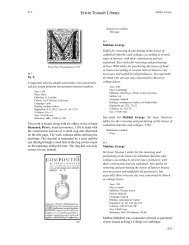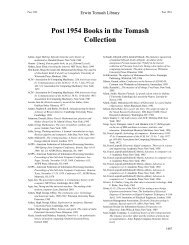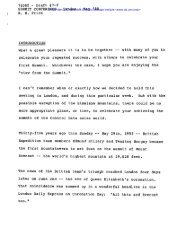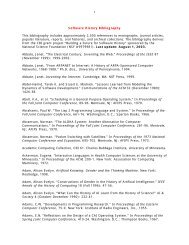B chapter.indd - Charles Babbage Institute - University of Minnesota
B chapter.indd - Charles Babbage Institute - University of Minnesota
B chapter.indd - Charles Babbage Institute - University of Minnesota
Create successful ePaper yourself
Turn your PDF publications into a flip-book with our unique Google optimized e-Paper software.
B 250<br />
Briggs, Henry (1561–1631)<br />
Arithmetica logarithmica sive logarithmorum chiliades<br />
triginta, pro numeris naturali serie crescentibus ab<br />
unitate ad 20,000: et a 90,000 ad 100,000.<br />
Year: 1624<br />
Place: London<br />
Publisher: W. Jones<br />
Edition: 1st<br />
Language: Latin<br />
Binding: contemporary reverse leather; rebacked; brown<br />
leather label<br />
Pagination: pp. [8], 88, [300]<br />
Collation: a–m 4 A–Q 6 R 4 4H 8 4I–4O 6 * 6<br />
Size: 324x199 mm<br />
Reference: Pogg Vol. I, p. 298; DSB II, p. 462; Hend BTM,<br />
#18, p. 40; Horb CC, #38, pp. 33; Car PMM, #116, pp.<br />
69–70<br />
Henry Briggs graduated from Oxford with an M.A. in<br />
1585 and remained there as a junior academic. He was<br />
elected as a Fellow <strong>of</strong> St. John’s College in 1589. In 1596,<br />
he was invited to be the founding pr<strong>of</strong>essor <strong>of</strong> geometry<br />
at the newly created Gresham College in London, where<br />
he worked lecturing and creating navigational tables.<br />
Shortly after Napier published his Mirifici logarithmorum<br />
canonis descriptio in 1614, Briggs obtained a copy<br />
and immediately recognized their value for navigation<br />
and other computations. He began to teach them to his<br />
students and soon saw that they would be easier to use if<br />
the base was changed to 10. Briggs visited with Napier<br />
Erwin Tomash Library<br />
Briggs, Henry Briggs, Henry<br />
B 250<br />
Briggs’ logarithms, B 250<br />
in the summer <strong>of</strong> 1615 and again in 1616, and after the<br />
two men had agreed on the proposed changes, Briggs<br />
began calculating the new base 10 logarithms. Napier<br />
took no part in this work as he was not well and died the<br />
following year. In 1617, Briggs supervised the printing<br />
<strong>of</strong> a translation <strong>of</strong> Napier’s work produced by Edward<br />
Wright, who had also died shortly after finishing it. In a<br />
preface to this translation, he justifies the change to base<br />
10 and includes a small table <strong>of</strong> logarithms <strong>of</strong> numbers<br />
from 1 to 1000 (the first chiliad).<br />
This volume contains logarithms for numbers from 1 to<br />
20,000 and from 90,000 to 100,000. It took until 1624<br />
to produce the table in this volume. Briggs did not start<br />
calculating logarithms in succession, but he used a number<br />
<strong>of</strong> critical logarithms (see illustrations) for 0, 10 1/2 , 10 3/4 ,<br />
etc. to calculate the others. Briggs wrote a preface in<br />
which he explained how to use logarithms and gave a<br />
plan for calculating the missing 70,000 numbers—even<br />
<strong>of</strong>fering to supply special paper divided into columns<br />
for anyone willing to help. He provided the difference<br />
between each adjacent value (see illustrations) and a<br />
method <strong>of</strong> calculating logarithms by interpolation from<br />
differences. The missing seventy chiliads were included<br />
in the second edition <strong>of</strong> this work published by Adrian<br />
Vlacq in 1628, although Briggs had, by this time, nearly<br />
completed the calculations himself. It was in the preface<br />
to this work that Briggs coined the terms characteristic<br />
and mantissa for the two portions (on either side <strong>of</strong> the<br />
decimal point) <strong>of</strong> a logarithmic number.<br />
Some copies <strong>of</strong> this work have an additional six pages<br />
containing the logarithms for 100,001 to 101,000 and a<br />
table <strong>of</strong> square roots from 1 to 200. This volume does<br />
not contain these extra pages, but they are to be found<br />
in another issue in this collection (see entry for Briggs,<br />
Henry; Arithmetica Logarithmica, 1624–another issue).<br />
These logarithms, together with those <strong>of</strong> Adriaan Vlacq<br />
mentioned above, form the basis from which almost all<br />
other logarithm tables were produced. At the end <strong>of</strong> the<br />
eighteenth century, the French produced the Tables du<br />
Cadastre, which are only available in manuscript form<br />
(see entry for Prony). Towards the end <strong>of</strong> the nineteenth<br />
century, Edward Sang (1805–1890) published a seven-<br />
205







